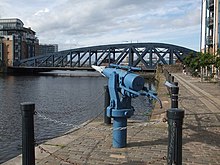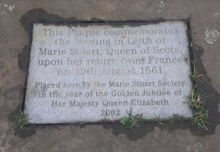The Shore is a historic and picturesque street in the centre of Old Leith, the harbour area of Edinburgh.

It edges the final section of the Water of Leith before it flows through Leith Docks into the Firth of Forth.
The Shore is a historic and picturesque street in the centre of Old Leith, the harbour area of Edinburgh.

It edges the final section of the Water of Leith before it flows through Leith Docks into the Firth of Forth.



The site had been a harbour since Anglo-Saxon times.
Due to its location it was the arrival point of several monarchs on historic visits to the city: Mary Queen of Scots (1561) before her Entry to Edinburgh; Anne of Denmark (1590) who stayed at the King's Wark before her coronation;[1] Charles II (1651); George IV (1822). Queen Victoria's visit of 1842 disembarked in Leith Docks rather than the Shore.[2]
In May 1544, during the war known as the Rough Wooing, an English army arrived in Leith intending to burn Edinburgh. On Monday 5 May, English ships unloaded heavy artillery on the quayside at The Shore, to be used against Edinburgh's gates and Edinburgh Castle.[3]
In April 1779 there was an unfortunate incident on the northern half of the Shore, with many lives lost. 70 Highlanders belonging to the 42nd and 71st Regiments were in position to board a ship but refused as it was rumoured they were to be transferred to a lowland regiment and would lose the right to wear a kilt. This was untrue, but even if true it seems a trivial start to what then ensued. Under order from James Oughton, 200 soldiers of the South Fencibles were sent out from Edinburgh Castle to quell the mutiny under command of Major Sir James Johnstone. The Highlanders refused to either surrender or lay down their muskets (which were fitted with bayonets). Both sides being heavily armed the tension quickly turned to bloodshed. One Highlander trying to run off was grabbed by a Sergeant of the Fencibles who was then bayonetted to make him loose his grasp. A second sergeant armed with a pike, was then shot by a Highlander. The Fencibles raised their muskets and fired into the group of Highlanders killing 12 men and mortally wounding many. The Highlanders having far less ammunition returned fire to less effect: two Fencibles killed and one injured. Captain James Mansfield, attempting to attend the latter, was cruelly bayonetted by a mutineer who in turn was shot in the head by a corporal. The Fencibles moved in with fixed bayonets and captured the 25 survivors who were then imprisoned in the castle. The total lives lost appears to be somewhere between 40 and 50. Mansfield was buried in Greyfriars Churchyard. The other Fencibles were buried in the open ground at the foot of Canongate Churchyard (which was reserved for deaths connected to Edinburgh Castle. The 40 Highlanders killed or dying of wounds were buried in South Leith Parish Churchyard. After a court martial, three further Highlanders were within seconds of being executed by firing squad: Williamson and MacIvor of the 42nd and Budge of the 71st. However a pardon was received from the Queen due to the valour of their regiment.[4]
The Shore was the first place in Leith to install public street lighting: oil lamps in 1771 (to combat a number of people falling in the river in the dark. It was also the first street in Edinburgh to have electric street lights (1895) served by a local generating station.[5]
Up until 1969 the water was tidal, but due to lock constructions in the outer edge of Leith Docks water is now permantently 1m higher than the old high tide level. For around a decade the outer lock was kept fully open once a year at low tide to allow silt in the river bed to flush out, but this routine halted when the inner harbour ceased to be navigable.
The Town Council plan for Leith (part of Edinburgh's Abercrombie Plan) from the early 1950s envisaged the entire demolition of the Shore and redevelopment as industrial sheds.[6] This was adapted to allow (and encourage) modern housing schemes and the demolitions and redevelopments crept towards the Shore in the 60s and 70s. Meanwhile, The Shore was left to rot. The final wave of scheduled demolition removed the buildings on the north side of Tolbooth Wynd. The northward progression then ceased, leaving the Shore in a limbo. By 1980 there were only two inhabited buildings, discounting the several ground floor bars which still managed to turn a profit. As part of its maritime background the area was also hindered by its use as a red light area.[7]
The secondary hindrance was a huge Health and Safety exclusion zone centred on Leith Docks, which prohibited new residential development due to the explosive value of fertilisers housed in Scottish Agricultural Industries for a radius of 1 km. This restriction was abandoned in 1983 eight years before SAI physically abandoned their dock site.[8]
This all began to turn around in the 1980s when a fashion for restoration, combined by very low property values in Leith, allowed a number of small property developers to risk some restoration schemes. This was hampered severely in that Leith (EH6) was blacklisted for mortgages. The first mortgage was given by the Alliance and Leicester Building Society in 1984, in relation to the Cooperage. Coupled with the housing revival the Shore and its environs became a magnet to restaurants and the new concept of gastro pubs.[9] In current times, Leith has three Michelin star restaurants: The Kitchin (Tom Kitchin), Martin Wishart[10] and Heron.
The widespread recession of the late 1980s brought development to a halt but it restarted in 1993 and from that point began a meteoric rise... going from one of the least desirable parts of the city to one of the most desirable. Rightly or wrongly it is perceived as a new yuppie stronghold despite the majority of new housing projects being for Port of Leith Housing Association.[11]
Lothian Buses service 15, 35 and 36 all stop on The Shore.
The Shore tram stop opened to passengers in June 2023. It is located 200 metres east along Bernard Street at the northern junction of Constitution Street.
| Preceding station | Edinburgh Trams | Following station | ||
|---|---|---|---|---|
| Port of Leith towards Newhaven |
Newhaven – Edinburgh Airport | Foot of the Walk towards Airport |
The north end of The Shore is also in close proximity to the Port of Leith tramstop, via Tower Place.
see[12]



